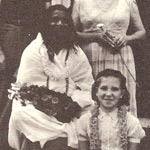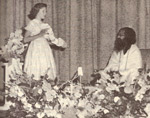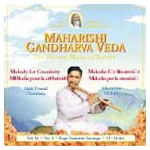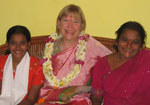Contribute
| The Eternal Music Of Nature: Maharishi Gandharva Veda |
Lee Leffler
01/10/2008
Theresa Olson was a young California girl when Maharishi Mahesh Yogi came from India and stayed at her family's home in 1959. Since then, six million people world-wide have learned Maharishi's Transcendental Meditation technique. As an adult, Maharishi trained Theresa to teach the Transcendental Meditation technique. She worked in public relations and the media. Theresa is married to Dr. John Sorflaten. She has a Bachelor of Arts in English Literature, and a Masters Degree in Rhetoric. Theresa earned her Ph.D. at Maharishi University of Management in Fairfield, Iowa on the subject of Maharishi Gandharva Veda music. Her experiments suggest that Maharishi Gandharva Veda music can be a powerful tool for balancing mind, body, and behavior. Dr. Olson answered my questions by email and phone. What is Maharishi Gandharva Veda? How is it different from most modern Gandharva Veda? The ancient Vedic texts delineate music of two types: desi which brings pleasure to the senses, and marga which focuses on enlivening those frequencies in nature which bring life into accord with natural law. Maharishi Mahesh Yogi inaugurated his Program to Create World Peace in 1986, and he introduced Maharishi Gandharva Veda music for promoting balance and peace. Since then, this music has been studied and performed by musicians who are highly trained and skilled in both theory and practice of Maharishi Gandharva Veda. Maharishi Gandharva Veda follows strict rules of melodies played according to proper season, proper time of day, proper instrumentation, proper intent. The music is for marga, for enlightenment. The alamkaras, or ornamentations, used in each Maharishi Gandharva Veda melody (raga) reflect the pure frequencies of nature. It takes some skill to produce these ornamentations. The students receive proper training in these precise and necessary structures of knowledge. Most importantly, the students also practice the Transcendental Meditation® technique in order to bring their conscious awareness to the level of the Unified Field of All the Laws of Nature, the field of pure consciousness, of pure intelligence, from which all sound arises. By attuning with this fundamental field of consciousness, the quality of music which such a musician plays resonates more purely with these primordial melodies and rhythms, thus making the music more powerful in its effects. Sitarist Debhu Chaudhuri oversaw the theoretical development of Maharishi Gandharva Veda music. He is a ninth generation Gandharva musician who immediately saw and understood Maharishi's vision. Why did you become interested in Maharishi Gandharva Veda? My parents invited Maharishi Mahesh Yogi to use our home for a few months back in 1959. Until 1968, he regularly stayed at our home whenever he visited the USA. In 1987 I was attending one of the first concerts on Maharishi Gandharva Veda offered at MUM in Fairfield Iowa USA. During the concert I found I was transcending for minutes at a time, no breath, no thoughts. The music became my metabolic rate, my inner thinking process settled into an amazing state of calm contentedness. I just found the stress from daily living melting away. I came away from the concert refreshed in mind, body and spirit. The same kind of experience happened during each of the concerts I attended afterwards. That made me wonder, "What is it about this music that produces such a sublime experience of calm?" And so my quest to answer this question became the focus of my Ph.D. dissertation. What did you learn about Maharishi Gandharva Veda? So that I could be objective in my studies, I purposefully avoided learning the mechanics of Maharishi Gandharva Veda, and how to perform Maharishi Gandharva Veda music. It was the first Ph.D. dealing with the topic of research on Maharishi Gandharva Veda in the West. I did my studies at Maharishi University of Management in Fairfield, Iowa. So little was known about the research topic that one of my outside advisors told the others that I had actually written five dissertations. So quite a lot of information is provided in a general way with this breakthrough study. The Journal of Social Behavior and Personality is a peer reviewed journal that published some of my research with the title "Empirical Investigation of the Effects of Maharishi Gandharva Veda Music During Live Concerts" in 2005. This study tested for relationships between exposure to live concert performances of Maharishi Gandharva Veda music and changes in feelings associated with Maharishi Ayur-Vedic doshas. Our 609 subjects in this study filled in a questionnaire before and after the concert that measured how they were feeling, which we later converted into measurements of vata, pitta and kapha emotional balance. The study showed that the concerts significantly balanced emotions, reduced tension (vata imbalance), decreased irritability (pitta imbalance) and reduced lethargy (kapha imbalance). (See Dr. Olson's dissertation abstract) Where can students learn Maharishi Gandharva Veda in America? Maharishi University of Management in Fairfield, Iowa offers a Bachelor of Arts degree and a minor in Maharishi Gandharva Veda. mum.edu How can our readers listen to Maharishi Gandharva Veda? Free short samples of are on the website Maharishi Gandharva Veda: The Eternal Music of Nature plus CDs are available for sale. Maharishi University of Management Press sells audio tapes and CDs of Maharishi Gandharva Veda, including an interview with Maharishi Mahesh Yogi on the subject, and a full range of instrumental and vocal selections. mumpress.com How can Maharishi Gandharva Veda help create peace? All of creation is constructed of sound frequencies. Combination of these sound structures produce melodies. The melodies and sound frequencies produced by Maharishi Gandharva Veda music resemble these frequencies structured by Natural Law. Some melodies are for specific purposes: e.g. the rain melody is specifically for bringing rain. And some melodies are for producing peace in the individual, the nation, the environment, the world. I encourage musicians in every country throughout our world to learn to play this music. They can create peace by playing those melodies of nature that structure peace. Play the melodies of peace. ®Transcendental Meditation, Maharishi Gandharva Veda, are registered or common law trademarks licensed to Maharishi Vedic Education Development Corporation and used under sublicense or with permission.
You may also access this article through our web-site http://www.lokvani.com/

Maharishi Mahesh Yogi and Theresa Olson in 1959

Young Theresa gives flowers to Maharishi

Many tapes and CDs of Maharishi Gandharva Veda are available online

Theresa Olson in 2007 with friends Ramya (left) and Uma